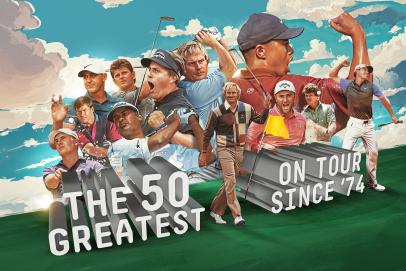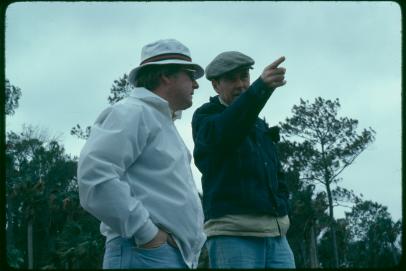Players Preview
The biggest change in pro golf in 50 years might be one you've never considered

Believe it or not, there’s one thing that’s changed more in the last 50 years of the Players Championship than beltless golf slacks, shirt collars, leather grips and metal spikes.
Specifically, we’re talking about launch conditions.
Now before you start rolling your eyes over some wonky dissertation on clubhead kinematics, the vagaries of spin loft, and lift and drag coefficients, consider this: Over the last half century, elite players might be nearly 60 yards longer because of increasingly optimized launch conditions. In short, golf’s leading lights in the early days of the Players were dramatically inefficient at launching tee shots properly. Today, they are nearing perfection and getting better all the time.
Yes, yes and triple yes, the technological developments in drivers and balls have been vast and far-reaching, but what those innovations ultimately have fueled is an ongoing race by players, teachers and equipment R&D types to optimize ball flight, making the theoretical more real (and spectacular) than a game of Golden Tee. Launch monitors like the ubiquitous Trackman and GC Quad, which litter the ranges of tour events today the way Marlboros and Winstons did in the past, have been widely used only for the last decade. But they have been in and around golf’s upper echelon of practitioners and engineers since the 1990s, pouring gasoline on this ever-escalating inferno of improvement. What these data machines have done is make it crystal clear that increasing the launch angle, reducing the spin—all while increasing speed—produces geometric increases in driving distance.
More from Golf Digest
And there’s no better tableau to see this optimization algorithm play out than the Stadium Course at TPC Sawgrass, site of the Players for the last four decades. Stout driving holes often require 3-woods today, while 5-iron approach shots—like Jerry Pate’s to wrap up the first Players contested at TPC Sawgrass in 1982—have been supplanted by wedges. In raw numbers, the average driving distance on the PGA Tour today is nearly 300 yards, or about half a football field longer than it was in 1980, the first year there were PGA Tour statistics. It is a different world in so many ways, and it's been changing TPC Sawgrass and the Players all along. Even in 2009, the course was playing differently than intended, with the driver being holstered more often than architect Pete Dye had designed.
So, what happened? Let’s break it down. This animation developed with FSX Play trajectory simulation software from Foresight Sports (makers of the GC Quad) shows how the launch conditions of the 1970s get completely obliterated by those of the more optimized current generation. Let us count the ways:
1. Swing speed
While there were no launch monitors to calculate swing speed a generation ago, a PGA of America study in 1980 showed the average tour clubhead speed was around 104 miles per hour. It’s probably safe to assume that in the mid-1970s it may have even been a touch slower. Remember, that was using wooden drivers with steel shafts, and while there are always outliers, the fitness craze had not yet come to the elite professional game, Gary Player notwithstanding. Today’s drivers weigh at least 15 percent less thanks to graphite shafts that heft about half as much as the steel they’ve replaced. Throw in biomechanically optimized training and overall improved technique, and you have swing speeds today that are more than 10 miles per hour faster, nearing 116 miles per hour. This year, nearly 100 tour players have recorded a swing speed of more than 120 miles per hour.
RELATED: Is a lighter driver better for you?
2. Ball speed
More swing speed means more ball speed. In the late 1960s, the seminal golf research book Search for the Perfect Swing estimated that a 100 mile per hour swing would propel the ball at 136 miles per hour. By today’s standards, that’s not only slow but laughably inefficient. In today’s optimized world, players know that the goal is to get to a ratio of ball speed to clubhead speed of 1.5. Even in the 1970s, players and equipment had progressed to produce ball speeds of 150-155 miles per hour with those 105 mile-per-hour swings. That’s pretty good for what it was, but with swing speeds on tour today in the 116 mile-per-hour range, ball speeds are now 173 miles per hour. An increase of 18 mph alone in ball speed would yield conservatively 36 yards in distance. But wait, there’s more.

3. Spin
Here is where club and ball technology upgrades over the last 25 years really start to make a difference. Think principally about the changes brought about with the introduction of titanium drivers (Callaway’s Great Big Bertha, Titleist’s 975D, Ping’s TiSi and TaylorMade’s R500 series) and balls (the Titleist Pro V1). In addition to faster ball speeds, titanium drivers and their flexible faces also launched the ball higher than wooden drivers ever could. As driver technology improved, more of the mass of the head moved lower internally. More weight low meant still higher launch and still less spin. Persimmon drivers had faces that did not flex, and the head itself had a much higher center of gravity. It was likely more in line with the top of the face than the middle of the face. That means more spin—way more, in fact. Those we spoke to who are somewhat familiar with the times said it would not be outlandish to expect some players of the bygone era to be producing tee shots with 4,000 rpm. Golf balls were made of soft balata covers around a blur of rubber windings, not the solid polybutadiene rubber cores of today, which also are surrounded by a firm, spin-killing mantle shell beneath the cover. As veteran fitter Dan Sueltz of D’Lance Golf mentioned to me, “The balata balls had so much spin the ball would balloon on players back then. I remember attending a tour event and standing maybe 50 yards in front of the tee. The sound of the ball spinning as it went down the fairway was crazy loud.” By contrast, today, the average measured spin rate on tour is more like 2,600 rpm, and more than 80 players produce less than 2,500 rpm with the driver. If you can combine low spin with high launch, well, you are in the high country in the distance game.

4. Launch angle
The final piece of the driving inefficiency puzzle of yesteryear is the angle the ball leaves at impact. Imagine the water coming out of your garden hose. If you want the rutabagas at the far end of the vegetable patch to get enough moisture, you have to angle that hose upward. But players of the last generation could not do that. Not because they didn’t want to. Jack Nicklaus said in Golf My Way that he tried to catch the ball slightly on the upswing with his driver, but if he did, he was an exception. The vast majority of tour-level swings hit slightly down on the ball, what’s called a negative angle of attack. They had to. It was the only way to counteract the high spin of the wound balata balls. As one expert of the era mentioned to me, players of that time were probably hitting down on the ball by three or four degrees. That downward hit meant a lower launching higher spinning shot with flights that looked sort of like a jet taking off from an aircraft carrier, low and slowly rising upward. The result of that downward strike was a launch angle that probably would have been as low as 6 degrees, but comfortably might have been around 7 or 8 degrees. By contrast, today the average launch angle on tour is about a third higher, at 10.6 degrees. Swings changed, yes, but they changed in concert with the technology of clubs and balls. Particularly as titanium drivers got larger, probably close to three times the front to back measurement of wooden drivers, they increased what is known as dynamic loft. Because the head's center of gravity was farther away from the face, the head comes into the ball with more of an upward angle. Again, high launch and low spin is the perfect mix for distance.
When you put all these optimized differences in the modern technology of Foresight Sports’ ballflight simulation software, you see a fundamentally transformative trajectory. While those higher-spinning, lower launching shots of yesterday’s technology could land hotter and produce a lot of bounce and roll, today’s tee shots often come with little compromise. The simulation shows modern shots fly almost 30 feet higher but still had similar shallow landing angles for even more roll. Our calculation shows 23 yards of roll for today’s launch conditions compared to 14 yards a lifetime ago. The ultimate difference in the two drives is 58 yards, 311 to 253.
While it’s certainly likely true that 50 years ago, plenty of drives went farther than the 253 yards our simulation shows, the average on the PGA Tour in 1980 was 256.5. At the end of last year, it was 299.9. The longest hitter on the PGA Tour back then was Dan Pohl with an average of 274.3 yards. He would have finished 193rd last year, more than 50 yards behind Rory McIlroy.


